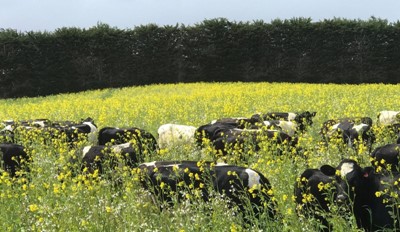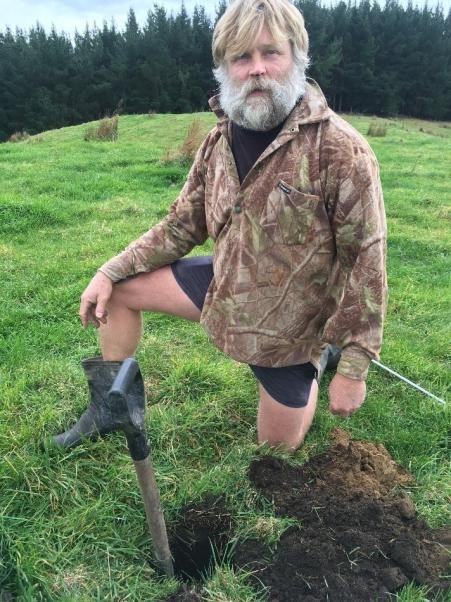Science has come charging to the rescue of regenerative agriculture in NZ.

All the farmers I know want the same clean rivers and abundant wildlife that everyone else does, says guest writer Siobhan Griffin of next.level.grazing@gmail.com
Some farmers don't want to play the maximize-production-at-all-costs game because there are no winners in the long run. As a result, regenerative agriculture has attracted some of the smartest young farmers in the business, who are staying on top of the latest soil science and are applying this knowledge to improve their farm management and environmental outcomes at the same time.
Dean Martin is second generation farmer on Glenlands, a farm which he operates with his wife Antoinette and children in Glengarry, Hawkes Bay. On June 12, 2019 I found him navigating his beautiful diverse farm shifting stock. When I say diverse, I mean landscape, forest, water, stock, pastures - everything!

We rode the side by side through a collage of native bush and plantation forest - but not just pine. The Martin's have planted Red Alder, poplar, and several varieties of oak. Some pockets in his landscape feel primeval. The bush is interspersed between paddocks like a tapestry while ponds and streams knit it all together. I was thrilled to see water cress growing in the clear water where soil holding grasses protect the waterway for trout and eel. Dean enjoys hunting and actively cultivates his diverse landscape to enhance bird habitat. Ducks and wild turkey abound.
Dean shifted his 160 twin bearing ewes and 90 single Texel cross ewes onto their daily break of diverse permanent pasture. Dean has put Wiltshire rams over all the ewes. Some ewes were eight years old and a few older. Dean explains when sheep graze diverse grasses and clovers that are allowed to grow longer their teeth don't wear out so fast because they are not eating down near the dirt.
The secret is keeping the grasses green and vegetative with dense mobs on more frequent shifts, leaving higher residuals and then giving the pasture enough time to recover to just before full maturity and before they set seed. I call this next level grazing and Dean has mastered it.
We wind our way through forest, gulley, and open hillside to shift the 57 cows and heifers that are in calf. Dean will buy an extra 40 sale barn calves to put on cows who will take an extra calf. Sixty R2 steers and ten R1 heifers are combined with the group and the mob is shifted onto a new break of diverse pasture daily before they can take the residual down very low.
A portable plastic water tub also gets shifted along with a salt block with selenium and cobalt so he can back fence the mob. Then the pasture can begin the generous recovery period aimed at growing more grass. Under foot the result of this labor is a kaleidoscope of plants including cocksfoot, timothy, plantain, dandelion, heaps of clover, perennial ryegrass, chicory, prairie grass, and brome grass.
His stock also includes 27 bulls on a separate paddock. Sixty Saanen goats which have been bred to Boer to help control blackberry at the forest edge, so Dean does not have to spray herbicide.
Dean likes to boost the performance of some of his pastures with an economical no-till seeding in March each year of oats, barley, rye corn, Italian rye, red clover, white clover, plantain, and chicory. In keeping with the six principles of regenerative agriculture, he does not disturb the soil with tillage but merely decks the paddock with stock before drilling through tine harrows. Dean uses the stock as a tool to trample the seed in for good seed to soil contact after drilling. Mindful of the science behind the knock-on benefits of healthy soil microbial life, he uses no glyphosate to burn down the pasture before planting.
It is a pleasure to see growing grass left in the pasture the stock have come off this winter. Stock are shifted before paddocks get muddy because Dean knows the importance of keeping the soil covered with what modern regenerative farmer, educator, and author Gabe Brown calls "soil armor". Stock require higher maintenance energy if left in a muddy paddock, so feed efficiency is better with a no-bare-soil policy. The taller pasture plants have roots which go down as deep as the plants are tall which helps hold the sod together in wet weather.
Dean likes having many classes of stock mobbed together. Fewer mobs grows more grass overall on the farm and keeps the paddocks grazed more evenly to keep more of it green and vegetative.
How does that work? With fewer groups more paddocks are resting and growing more feed at any one time.
The ewes and lambs all gradually get mobbed up together by October. The hogget's and their lambs are in a separate mob. All the stock are in great condition on the day I was there even with the very dry Autumn and paddocks on Dean's farm were greener than most in the region. Dean took a spade to the paddock and the dark topsoil was like potting mix and went down 50 cm.
For further information on regenerative farming - for farmers who want to learn more can go on Facebook and look for these regenerative farming pages:
Or go to websites like:
Thank you Siobhan for another interesting look at regenerative farming in practice.
Keep asking great questions ...